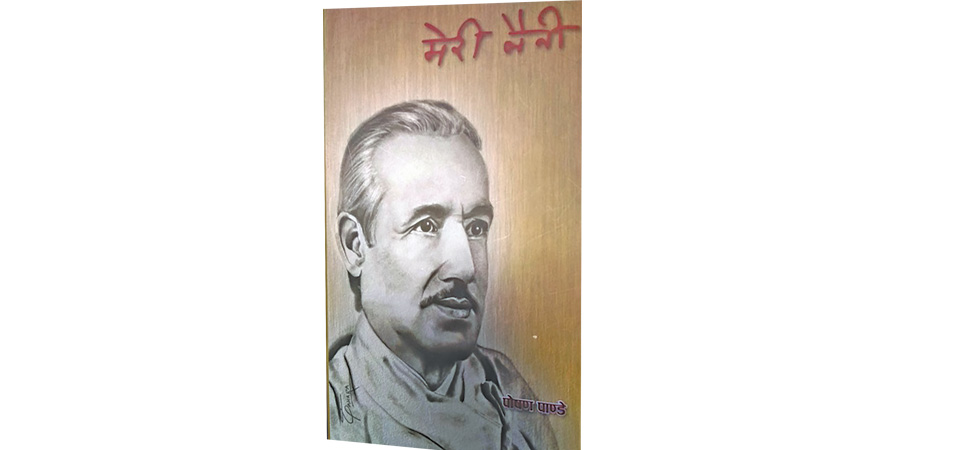Poshan Pandey’s Meri Naini

Gandhi Raj Kafle
The recognition of the story writer is an earned and noticed identity for late litterateur Poshan Pandey. But, is it the sole identity for him? Here is the under review poetry book entitled “Meri Naini”, which reveals dazzling facts more than two and half decades after the demise of the author.
The late author’s literature loving family has formed a foundation to acquaint Nepali readers with the multi-dimensional creative personality of Poshan Pandey and to promote literary activities for remembering him in the days to come. This is some good news for readers of Nepali literature.
But, the question to talk about the under review Meri Naini here is – how was Poshan Pandey as a poet? The facts discussed by noted critic Dr Govinda Raj Bhattarai in his preface to this book tell a lot about Pandey’s talent to compose poems. In fact, what is overshadowed in a lifetime may come to limelight even after demise of an author. The publication of Meri Naini has provided proof of this kind in this context.
Now, the poetry book by Pandey is here and the Nepali readers who know him as a story writer or a few of them who also know about his poetic talent both can read the late author’s poems and feel how artistic he was in dropping personal and social messages in the art of poems.
In fact, this collection contains both short and medium size poems. As far as poetic expression is concerned, the poem's size is not barrier for Pandey to embellish his ideas. He is effective in dropping messages in all kinds of poems.
The other point, which must be noted, is the poet in his poems of this collection is also artistic to demand patience from readers with impressive lines of words in the beginning just with an aim to take the height of expression and in such situation his messages for readers have been more beautiful.
Pandey’s this posthumously published anthology contains sixty-two Nepali poems. The themes with which he has played for the poems are numerous. He has churned out powerful meanings from themes like the context of flowers to context. Sometimes he is very deep, but the aim of the poet is to magnify the meaning of life and he is according poetic justice for everyone.
Some poems in this collection have been effective even to present the whole story of a life from within one or two pages of his poetic expressions. The poem entitled “Khyaka” and “Nitanta Kalidas” are the exemplary poems of such quality.
Similarly, the poet is accurate in the use of metaphors in short poems, too. The starting poems entitled “Muhan” (source), where we find only fifteen lines, is one such poem. Here, the poet is referring to the all-time flowing waters of Baise Dhara (twenty-two stone spouts) of the famous picnic spot at Balaju in Kathmandu to meaningfully point at the nation’s hidden malpractices and designers of such ill-acts; which is, no doubt, an all-time poetic message.
In fact, this newly published anthology “Meri Naini’ contains poems, which seek values of life in measured poetic words and is the way of his expression. In this bid, the poet has often been philosophical, too, but this quality has not burdened the poetic messages rather it has sweetened the poems because he has succeeded in showing the essence of life symbolically.
Gone are the days that never return. Life, too, is temporary and short. However, good work is done and left behind before death no matter how long it takes to be recognised and finally appear before the public. Here, Meri Naini’s sweet poems have reminded us of this fact.
Similarly, what we have here to think over about poetry is from poet Poshan Pandey himself. He says “Poem is the pure sentimental flow of heart and it breaks directly from compassion”. Such a thought does not build up without devotion.
Another prominent thought, which is relevant to mention in the context of poetical creations of the late Pandey, is by critic Dr Govinda Raj Bhattarai. He emphasises, ‘litterateurs gets established with the success of a particular genre, but the other equally powerful talent which comes up in his creative life does not get noticed or bound to be overshadowed. We do not look back, reevaluate and adjust contributions of litterateurs properly’. This should be changed, litterateurs’ works need to be evaluated and recognised in time.
Finally, the literary value of Meri Naini can’t be small just because it came late. It is for now and the future.
Recent News

Do not make expressions casting dout on election: EC
14 Apr, 2022
CM Bhatta says may New Year 2079 BS inspire positive thinking
14 Apr, 2022
Three new cases, 44 recoveries in 24 hours
14 Apr, 2022
689 climbers of 84 teams so far acquire permits for climbing various peaks this spring season
14 Apr, 2022
How the rising cost of living crisis is impacting Nepal
14 Apr, 2022
US military confirms an interstellar meteor collided with Earth
14 Apr, 2022
Valneva Covid vaccine approved for use in UK
14 Apr, 2022
Chair Prachanda highlights need of unity among Maoist, Communist forces
14 Apr, 2022
Ranbir Kapoor and Alia Bhatt: Bollywood toasts star couple on wedding
14 Apr, 2022
President Bhandari confers decorations (Photo Feature)
14 Apr, 2022










